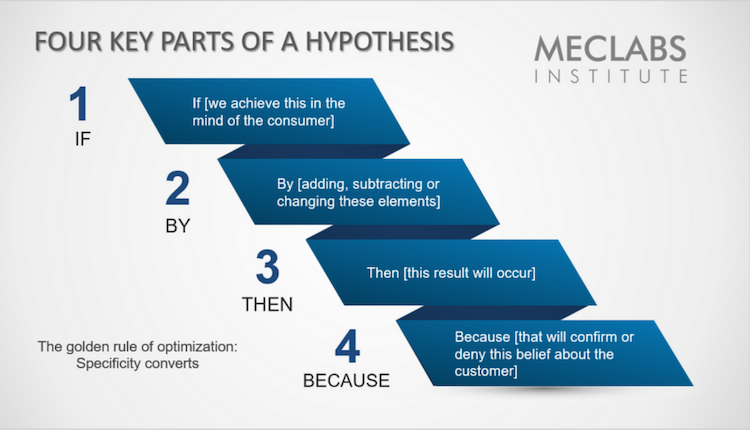Designing Hypotheses that Win: A four-step framework for gaining customer wisdom and generating marketing results
There are smart marketers everywhere testing many smart ideas — and bad ones. The problem with ideas is that they are unreliable and unpredictable. Knowing how to test is only half of the equation. As marketing tools and technology evolve rapidly offering new, more powerful ways to measure consumer behavior and conduct more sophisticated testing, it is becoming more important than ever to have a reliable system for deciding what to test.
Without a guiding framework, we are left to draw ideas almost arbitrarily from competitors, brainstorms, colleagues, books and any other sources without truly understanding what makes them good, bad or successful. Ideas are unpredictable because until you can articulate a forceful “because” statement to why your ideas will work, regardless of how good, they are nothing more than a guess, albeit educated, but most often not by the customer.
20+ years of in-depth research, testing, optimization and over 20,000+ sales path experiments have taught us that there is an answer to this problem, and that answer involves rethinking how we view testing and optimization. This short article touches on the keynote message MECLABS Institute’s founder Flint McGlaughlin will give at the upcoming 2018 A/B Testing Summit virtual conference on December 12-13th. You can register for free at the link above.
Marketers don’t need better ideas; they need a better understanding of their customer.
So if understanding your customer is the key to efficient and effective optimization and ideas aren’t reliable or predictable, what then? We begin with the process of intensively analyzing existing data, metrics, reports and research to construct our best Customer Theory, which is the articulation of our understanding of our customer and their behavior toward our offer.
Then, as we identify problems/focus areas for higher performance in our funnel, we transform our ideas for solving them into a hypothesis containing four key parts:
- If [we achieve this in the mind of the consumer]
- By [adding, subtracting or changing these elements]
- Then [this result will occur]
- Because [that will confirm or deny this belief/hypothesis about the customer]
By transforming ideas into hypotheses, we orient our test to learn about our customer rather than merely trying out an idea. The hypothesis grounds our thinking in the psychology of the customer by providing a framework that forces the right questions into the equation of what to test. “The goal of a test is not to get a lift, but to get a learning,” says Flint McGlaughlin, “and learning compounds over time.”
Let’s look at some examples of what to avoid in your testing, along with good examples of hypotheses.
Not this:
“Let’s advertise our top products in our rotating banner — that’s what Competitor X is doing.”
“We need more attractive imagery … Let’s place a big, powerful hero image as our banner. Everyone is doing it.”
“We should go minimalist … It’s modern, sleek and sexy, and customers love it. It’ll be good for our brand. Less is more.”
But this:
“If we emphasize and sample the diversity of our product line by grouping our top products from various categories in a slowly rotating banner, we will increase clickthrough and engagement from the homepage because customers want to understand the range of what we have to offer (versus some other value, e.g., quality, style, efficacy, affordability, etc.).”
“If we reinforce the clarity of the value proposition by using more relevant imagery to draw attention to the most important information, we will increase clickthrough and ultimately conversion because the customer wants to quickly understand why we’re different in such a competitive space.”
“If we better emphasize the primary message be reducing unnecessary, less-relevant page elements and changing to a simpler, clearer more readable design, we will increase clickthrough and engagement on the homepage because customers are currently overwhelmed by too much friction on this page.”
The golden rule of optimization is “Specificity converts.” The more specific/relevant you can be to the individual wants and needs of your ideal customer, the more likely the probability of conversion. To be as specific and relevant as possible to a consumer, we use testing not as merely an idea-trial hoping for positive results, but as a mechanism to fill in the gaps of our understanding that existing data can’t answer. Our understanding of the customer is what powers the efficiency and efficacy of our testing.
In Summary …
Smart ideas only work sometimes, but a framework based on understanding your customer will yield more consistent, more rewarding results that only improve over time. The first key to rethinking your approach to optimization is to construct a robust customer theory articulating your best understanding of your customer. From this, you can transform your ideas into hypotheses that will begin producing invaluable insights to lay the groundwork for how you communicate with your customer.
Looking for ideas to inform your hypotheses? We have created and compiled a 60-page guide that contains 21 crafted tools and concepts, and outlines the unique methodology we have used and tested with our partners for 20+ years. You can download the guide for free here: A Model of Your Customer’s Mind
You might also like …
A/B Testing Summit free online conference – Research your seat to see Flint McGlaughlin’s keynote Design Hypotheses that Win: A 4-step framework for gaining customer wisdom and generating significant results
The Hypothesis and the Modern-Day Marketer
Customer Theory: How we learned from a previous test to drive a 40% increase in CTR




Awesome work.Just wanted to drop a comment and say I am new to your blog and really like what I am reading.Thanks for the share